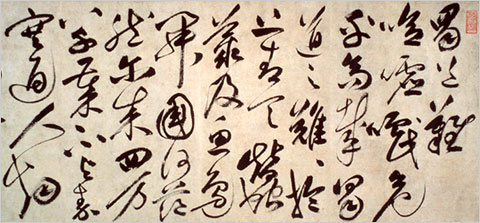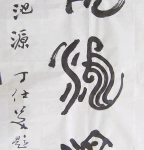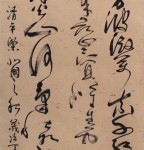Detail of a Ming Dynasty scroll by Zhu Yunming in the cursive script.
The Times recently published an article about China’s effort to manage the vast number of characters in the Chinese language.
A government computer database, designed to recognize people’s names on identity cards, is programmed to read about 32,000 of the roughly 55,000 Chinese characters, cutting out the more “obscure” characters.
This is not the first attempt to modernize a sprawling and ancient language. The most ambitious effort was the introduction to a simplified system of writing in the 1950s. As part of the Communist Party’s campaign to reduce illiteracy, simplified characters were promoted as the common written language, replacing many traditional characters.
More than five decades later, simplified characters remain the standard writing system of China, while Chinese elsewhere — especially in Taiwan and Hong Kong — continue to use traditional characters.
We asked several experts to explain the roots of this shift, and how it might affect the future course of the written language.
Eileen Cheng-yin Chow, professor of Chinese literary studies Eugene Wang, professor of Asian art Hsuan Meng, writer, World Journal Norman Matloff, computer scientist
--------------------------------------------------------------------------------
The Utopian Ideal in Writing
 Eileen Cheng-yin Chow is an associate professor of Chinese literary and cultural studies at Harvard University.
Eileen Cheng-yin Chow is an associate professor of Chinese literary and cultural studies at Harvard University.
The utopian impulses behind standardization and simplification of a living language are always understandable. Increased literacy, administrative efficiency, and ease of communication are laudable goals. But those impulses can also strip a language of its wit, whimsy, and play, not to mention its capacity to accommodate new concepts and usages.
Traditional characters and simplified characters never were two separate and autonomous language systems — they have always existed on a continuum. Many simplified characters are adaptations from common usage in Chinese cursive script; on the other hand, the inability to read traditional characters is to close oneself off to much of the Chinese cultural legacy — its history and arts — before the 1950s.
Since I grew up in Taiwan, where reading and writing in traditional characters is the norm, simplified characters were a novelty and a bit of a challenge, and perhaps, something to be sniffed at. But when my first job after college led me to Beijing to work as a literary translator, I spent the first week furtively consulting a little manual of “Simplified/Traditional Character Conversion” before I became fully comfortable with the new system, including learning to write my name in a way that was comprehensible to desk clerks. The experience taught me the follies of being a cultural purist.
Given the increasing flow of published and online materials among the mainland China, Taiwan, and the overseas Chinese diasporas, a literate reader must have the ability to code-switch. Thus, the answer is not either/or, but — annoyingly for policy makers — both.
--------------------------------------------------------------------------------
Elitism vs. Populism
 Eugene Wang is the Abby Aldrich Rockefeller professor of Asian art at Harvard University.
Eugene Wang is the Abby Aldrich Rockefeller professor of Asian art at Harvard University.
Simplifying traditional Chinese characters was a linguistic democratization and one of China’s most successful progressive programs in the 1950s. The majority of the population was lifted out of illiteracy.
Literacy had long remained a privilege and a source of power wielded by the elitist few. With the characters made easier to learn, the key to knowledge embedded in written texts was handed to a wide population.
A clash between traditional and simplified characters comes down to elitism vs. populism. A recent poll conducted by Sohu.com on whether to reinstate the traditional characters shows that more netizens oppose it. Behind the elitism/populism divide is the opposition between an archaistic nostalgia toward the illusory “purer” traditional Chinese literacy and a pragmatic and forward-looking modern drive. (Both Singapore and Malaysia, with sizable Chinese populations, also adopted simplified characters decades ago.)
Advocates for reinstating traditional characters exaggerate the break of the simplified system from the traditional orthography. Simplified characters still retain the basic structure of traditional ideographs. The structural continuity makes the switch between them easy and smooth, a skill any educated person can quickly acquire. Many of the simplified characters had been in existence for more than a millennium. Manuscripts unearthed from ancient tombs and medieval caves suggest that some simplified characters now used were already in currency then. The reform in the 1950s only officially legitimated these underground “outlaw” vernacular characters.
Aesthetic appeal is another argument made for reinstating traditional characters. Calligraphy, the quintessential aesthetic form of Chinese writing, in fact favors simplification. The running- and cursive-hand in Chinese calligraphy has always been the most radical form of simplifying characters. The six-stroke character xing (running), for instance, was reduced to a mere two vertical strokes in medieval calligraphic practice.
It’s true that computer keyboarding has now made the dreaded writing of multi-stroke-characters mostly moot. But why require schoolchildren to spend time and cognitive energy learning overly complicated ideographs in this age of information explosion, so vastly different from traditional society? Why not let them acquire the simplified form first, and if they desire, move on to master traditional characters? The first step is for efficiency; the second is for cultural refinement. That is why every society has the division of labor between bankers and poets.
--------------------------------------------------------------------------------
The Chinese Canon, Diminished
Hsuan Meng writes a column for World Journal Weekly.
Language is about cultural identity. This is especially true in the case of the written Chinese language, which has evolved for at least three millenniums and is now used by one and a half billion people worldwide. Given the language’s long history, future Chinese readers and writers may have to live with the consequences of current decisions long after today’s powers and regimes have ceased to exist.
The advantage of traditional characters is that they offer a stronger and richer connection with the history of the Chinese language. The simplified writing system has reduced the variety and changed the nature of many character shapes, making it more difficult for people to access classical texts in their full richness.
This is more than an academic concern. Just as Shakespeare’s plays and the language he used serve as a foundation for the English language, so are the canonical writings of Confucius, Lao Tzu and countless others who had exploited the full range and expression of the traditional characters.
Proponents of simplified characters say that simplified characters are easier to learn. But I have found no rigorous study that fully proves this. Moreover, some studies have shown that because the simplification process, by warping the shapes of characters, can cause confusion in the meaning of characters.
In Taiwan and Hong Kong, schoolchildren have no trouble learning traditional characters, and those regions demonstrate some of the highest literacy rates in the world. Meanwhile, in recent decades, the People’s Republic has implemented policies that implicitly acknowledge the practical, cultural and aesthetic values of traditional Chinese: some traditional characters have been restored to use, and the government permits traditional characters in the practice of calligraphy.
The push to simplify Chinese reflects contemporary political agendas more than a desire for a good solution. We should find ways to promote coexistence of both systems of writing.
This essay was translated from the Chinese by Victoria Meng.
--------------------------------------------------------------------------------
How a Computer Might Respond
 Norman Matloff is a professor of computer science at the University of California, Davis, and is the author of KuaiXue, a software tool for learning Chinese.
Norman Matloff is a professor of computer science at the University of California, Davis, and is the author of KuaiXue, a software tool for learning Chinese.
The original rationale for simplification was to accelerate the learning process. But is this necessary today, given China’s much improved economic and social conditions? There may be no easy answer.
What’s certain is that converting from the simplified characters, or jiantizi, to the traditional characters, fantizi, would be a huge task, affecting everything from school textbooks to government documents to online systems. Automation of that process would present serious technical challenges.
The trouble stems from fundamental differences in the two character sets. The simplification process of the 1950s sometimes resulted in two different traditional characters becoming identical in simplified form. For instance, the traditional characters 發 (”develop”) and 髮 (”hair”) are both written as the simplified character, 发. When the software sees the latter, it must guess which of 發 and 髮 is intended. Typically the guess is made by analyzing context. Sometimes, the software can produce the occasional howler. A passage describing “loss of face” might be translated by the computer as loss of 麵 (”noodles”) rather than loss of 面 (”face”)!
So while most of the process could be automated, especially with more fine tuning in the software, much work would need to be done by hand as well.
| < Prev | Next > |
|---|
- 2011-11-24 - 中国书协授予佛山市“中国书法城”称号
- 2011-11-21 - 丁仕美先生为山西左云大楞严寺楞严宝刹撰写楹联
- 2011-11-19 - 白谦慎-中国书法海外研究简介
- 2011-08-03 - Big Seal Script Stele, Old Dragon Hill(Lao Long Shan)
- 2011-07-08 - “Dwelling in the Fuchun Mountains.” A Reunified Painting Stirs Big Thoughts in China and Taiwan
- 2011-06-28 - Masters Of Modern Chinese Painting Exhibition in Venice Roma, Italy
- 2011-06-28 - 深圳书法家王乃栋谈创作 - 中国书法的价值在美丑不在新旧
- 2011-05-22 - 中国古典诗词在西方世界的传播及其影响
- 2011-05-11 - 2011 6th Affordable Art Beijing Festival
- 2011-05-10 - Calligraphy in China Japan and Korea













